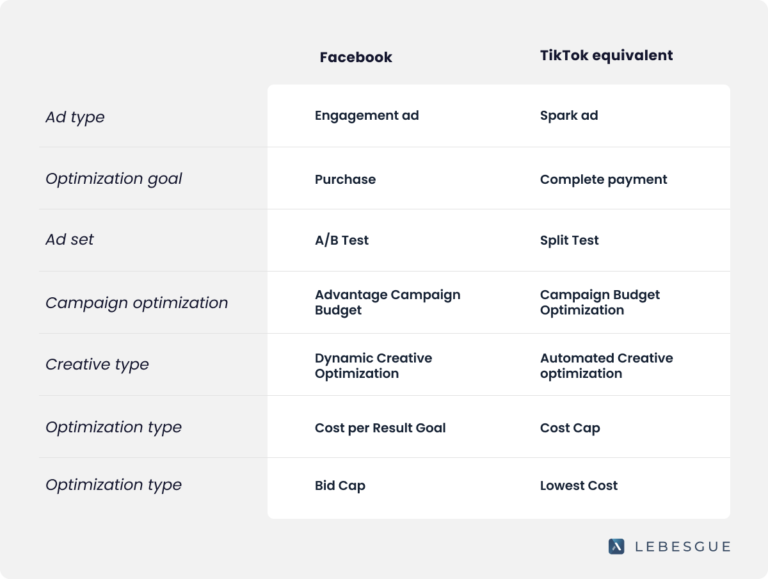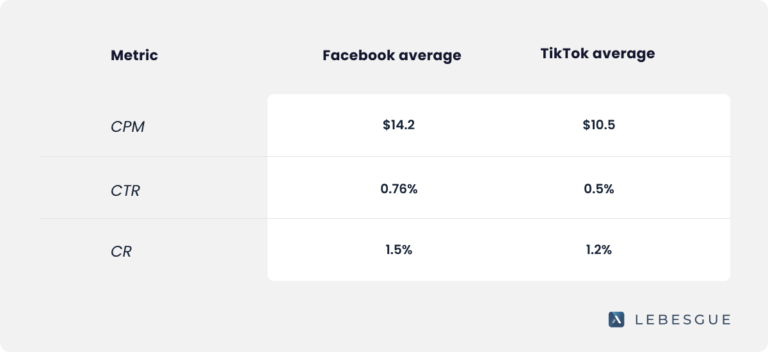JOIN OUR WHATSAPP GROUP. CLICK HERE
TikTok Ads vs. Facebook Ads TikTok advertisements versus Facebook ads. The most frequent query is, “Which platform is better for my business?” despite the fact that both platforms have a lot of interest. Two of the most popular places to run ad campaigns are Facebook and TikTok. It’s critical to comprehend the distinctions between the two platforms because each has distinct characteristics and a distinct target audience.
Everything in this blog article relates to Facebook advertisements vs. TikTok ads. The fundamental distinctions between Facebook and TikTok adverts will be discussed first. The cost and performance comparison will be shown to you as we go deeper into our investigation.
Facebook ads vs. TikTok ads: Basic differences
As we previously stated, it’s critical to comprehend the primary distinctions between Facebook and TikTok ads. Let’s start by looking at formats and ad targeting to assist you choose which one is best for your company.
TikTok Ads vs. Facebook Ads – Differences

There are four main aspects of an ad that you’ll need to overview: format, targeting, costs, and performance.
TikTok Ads vs. Facebook Ads – Ad Formats
Both platforms offer ad placement in multiple formats. For some campaigns, a picture ad makes perfect sense, while for others, a video is more suitable. Here is a comparison of the various formats the two platforms offer.
Facebook Ad Formats

Facebook offers seven broad ad formats:
- Image ads: Ever seen a compelling image that persuades you to click? Image ads are simply that, an image with a compelling copy.
- Video ads: This one is also what it sounds like, an attractive video and a copy.
- Carousel ads: Imagine a mini-gallery that your audience can’t resist swiping through. Carousel ads comprise scrollable images or videos gathered together into a single ad.
- Collection ads: A combination of images or videos with a cover image that showcases multiple products.
- Slideshow ads: Ads that utilize a series of images or videos to create a slideshow-like format. The slideshow usually advanced automatically, unlike with carousel ads.
- Instant experience ads: Full-screen mobile ads that provide an immersive experience, including images, videos, and interactive elements.
- Messenger ads: This type of ad randomly pops up in the Messenger app and allows your target audience to initiate a conversation with you.
TikTok Ad Formats

TikTok is a video-only platform, so expectedly, it does not offer as much options as Facebook does when it comes to ad formats, but nevertheless, there are several ways people often promote their products on TikTok. Here are some:
- In-Feed ads: This type of ad works in a similar way to ads on Facebook. They appear randomly among other content on TikTok.
- Brand Takeover ads: That first ad you notice the moment you launch your TikTok app is a brand takeover ad. It is costly, but there’s a guarantee it won’t get buried amidst other content.
- TopView ads: These are just like the brand takeover ads, but they take longer to disappear.
- TikTok Live ads: Live ads leave your audience no escape route as they pop up during a TikTok live video.
TikTok has more alternative ways for your brand to reach a wider audience. While these methods are marketing, they’re not exactly “ads” in the truest sense of the word:
- Branded hashtag challenges: These are not exactly ads, but it is a way of promoting your brand. You get the TikTok community buzzing with excitement by creating unique hashtag challenges, inviting users to participate by creating and sharing their own videos.
- Branded effects: You have to be creative for this one. You create filters, stickers, and special effects carrying your brand name or logo. Users can then add them to their videos.
- Influencer marketing: With this, you leverage the influence of popular TikTok creators, urging them to promote your product.
TikTok Ads vs. Facebook Ads – Ad Targeting

One of the key differences between Facebook and Tiktok is in their targeting options. Targeting, in simple terms, is how you ensure you are not wasting money by displaying your ads to the wrong people. Most ad providers charge you for showing the ad a certain amount of times.
With targeting, you can avoid pushing your ad to a random person who has no interest in your brand. You can instead display it to only high-school gamers living in Asia (if that’s your particular niche) or any similar description of your target audience. It narrows your ad’s reach, but this is a good thing. If the ad is targeted exactly to the people most likely to use your services, then you’re more likely to get a better return on investment on the ad.
Facebook vs. TikTok Targeting Options

Facebook has arguably the most advanced targeting options of all popular social media. Advanced targeting options mean you can save money by describing the exact kind of person you want to show your ads to. Here are some of the targeting options you can find:
- Location targeting
- Demographic targeting
- Interest targeting
- Behavior targeting
- Life events targeting
- Workplace targeting
Facebook also has a few advanced options, such as lookalike audience targeting that sets up an audience close to your existing user base.
TikTok has similar options for location, demographics, behavior, and interests, but the connections and workplaces options are not as advanced.
TikTok Ads vs. Facebook Ads – Ad Cost

It is extremely difficult to accurately compare the cost of ads on platforms like Facebook and TikTok because it can vary depending on various factors, like ad format, targeting options, audience demographics, competition, and campaign objectives.
The most accurate method of measuring the cost of ads is by using metrics like cost-per-click (CPC) and cost-per-thousand-views (CPM).
The average cost per click (CPC) on Facebook is around $1.84, while the average cost per thousand impressions (CPM) is around $14.20. On TikTok, the average cost per click (CPC) is around $1.63, while the average cost per thousand impressions (CPM) is around $10.5.
TikTok’s ad costs, for example, might be lower, but you should not forget that Facebook has about three times the number of TikTok’s active monthly users.
On the other hand, while Facebook boasts of more users, remember that TikTok has a higher concentration of younger users. So, choosing a platform should ultimately depend on your target audience what you plan to promote.
TikTok Ads vs. Facebook Ads – Ad Performance

The usual way of measuring ad performance is through a metric called CTR (click-through rate). CTR is measured by dividing the number of clicks on your ad by the number of times your ad is displayed to users.
CTR can vary depending on your industry, audience, ad type, and campaign objective.
According to WordStream, the highest CTR for Facebook ads is in the Pets & Animals industry, with 1.68%, while the lowest CTR belongs to the Technology industry, with 0.47%.
Generally, the average CTR for Facebook ads across all industries is around 0.8%.
TikTok, on the other hand, has an average CTR of about 0.5%. This means that users are generally more likely to click on a link in a Facebook ad than a TikTok ad.
The higher CTR on Facebook can be linked to the fact that simply optimizing your ad copy gives you a higher chance of getting it clicked. On TikTok, you have to provide great visual content, which is a little harder, and have a younger audience who has a shorter attention span and brand awareness.
Summary
To summarize this post, here is a table for equivalent functionalities on Facebook and TikTok, with different naming conventions.

And here is a table with key metric comparison – taking into the account US market market, ad spent between $10k and $150k and, and product AOV between $50 and $200.

Choose The Right Platform For Your Ad
It can be difficult to pick the best platform for your promotions. Consider your alternatives carefully while keeping your budget and target market in mind, or ask an experienced ad management business for assistance.
JOIN OUR TELEGRAM CHANNEL. CLICK HERE

Be the first to comment